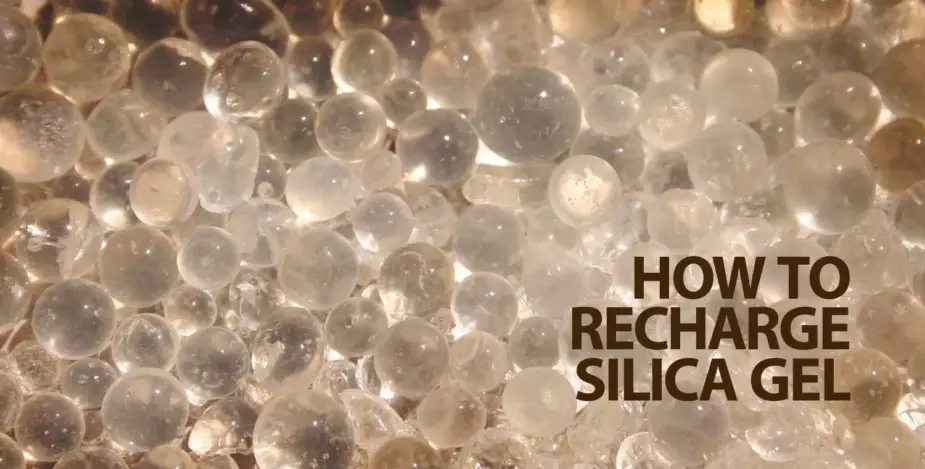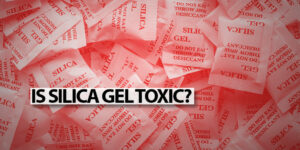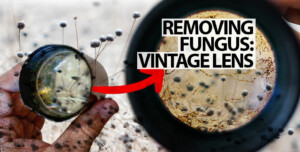Photographers use Silica Gel in their camera bags, and lens storage all the time. Often, though, I find that they don’t know that Silica Gel needs to be recharged after it has been used for a while. This is because as it absorbs water, it becomes saturated. Not recharging the Silica Gel regularly, can lead to excess humidity in camera and lens storage, meaning that they could be affected by Lens Fungus.
What Is Silica Gel? How Does It Work?
Silica gel is made from quartz sand and a few other chemicals. It’s a relatively inert chemical that is highly porous, and has a high capacity to adsorb material. It can adsorb up to 37% of its weight in water vapor. Silica gel is also resistant to mold and bacteria. It is non-toxic.
Silica gel is available in different forms: beads, granules, and powder. For photographers, I would suggest using the beads as they’re the least likely form to leave a powder residue.
As mentioned, Silica Gel is an adsorbent – a substance that removes moisture from the air. It can be used to maintain low Relative Humidity (RH) in an enclosed space.
In this way, it prevents fungus growth on camera lenses. Over time, Silica Gel becomes saturated with the moisture that it has adsorbed, and loses its ability to continue removing humidity from the air. At this point it needs to be recharged by careful re-heating and subsequent cooling of the beads.
Silica Gel can be reused many times, in this way, and continues to work with high efficiency, even after hundreds of reuses.
Types of Silica Gel:
You can get Silica Gel beads in a few different types:
- White, non-indicating Silica Gel
- Blue to Pink Indicating Silica Gel
- Orange to Green Indicating Silica Gel
We suggest using the orange-green indicating silica gel beads. This is a good option for a number of reasons.
- It’s easy to know when it needs to be recharged
- It’s non-toxic, and safe to be used at home
- Usable in a comfortable temperature range
How To Dry & Reactivate Silica Gel:
You can Dry Silica Gel in an oven at 120°C (248°F) for 1-2 hours to recharge it almost completely. This method is tried and tested, and is safe for your Silica Gel.
Heating Silica Gel too much could inactivate the indicating dye, and heating it for too long would simply waste energy.
7 Steps to Dry-Out & Reuse Silica Gel Repeatedly:
- Spread the Silica Gel across the bottom of a bake-safe oven dish (you can use aluminum foil if you prefer to keep it off the dish itself). Spread the beads or crystals evenly and less than an inch deep in the dish.
- Place the dish in an oven and heat it to 120° C (248° F) for 1–2 hours. When the Silica Gel has returned to its original color, it is ready to be taken out.
- Do not heat Indicating Silica Gel to more than 125-150° C because it will lose its indicating ability.
- Do not heat any Silica Gel to more than 200° C as its fine internal structures will be destroyed.
- The Silica Gel beads release the trapped water from within them and will revert to their original blue or orange color. Once the color changes fully, the Silica Gel is recharged and restored to its original capacity.
- To speed up the drying process, you can spread the gel out as much as possible, use a fan to circulate air, and periodically move around the Silica Gel layers to dry it out evenly.
- Finally, allow the Silica Gel to cool inside the oven. Finally, quickly return it to a sealed airtight container, ready for later use.
How To Tell If Silica Gel Needs More Drying
- When Indicating Silica Gel changes color, it is telling you that it is full of moisture. You should recharge it (dry it out) at this point.
- Orange Indicating Silica Gel desiccant turns green, and Blue Silica Gel turns pink.
- Because normal Silica Gel is white, it is difficult to tell when it has become saturated with moisture. On the other hand, it is easy to tell when Indicating Silica Gel is saturated. This is why I prefer to use Indicating Silica Gel.
- If you already have white Silica Gel, you could buy some indicating silica gel, and mix indicating and non-indicating Silica Gel. The Indicating silica gel will help you to judge the condition of all your Silica Gel combined.
- Finally, I like to keep a Hygrometer in my camera’s dry box, so that I know what the RH is at all times. When it starts to rise above 50% RH, I recharge my Silica Gel beads
Reusing Silica Gel Multiple Times
When exposed to humid air for an extended period of time, Silica Gel adsorbs moisture from it. Its microscopic pores become saturated with water. If your camera case is not airtight, more moisture will continue to enter it until the air becomes humid, once again posing the risk of lens fungus.
This is why you should keep your cameras and lenses in an airtight box when in storage.
Drying your Silica Gel on a regular basis allows you to keep your camera equipment safe from fungal growth, by keeping the humidity low.
The good news is that you can easily dry out (or recharge) your Silica Gel beads and use them repeatedly, to keep your camera equipment safe from fungus growth and moisture damage.
How Many Times Can Silica Gel Be Reused
Silica Gel can be reused up to 500 times or more. Silica Gel’s efficiency decreases after about 100 uses, but it still remains quite efficient at removing moisture from the air almost indefinitely, as long as it is not overheated, and its internal structure is not destroyed.
How Much Moisture Can Silica Gel Remove From the Air?
Silica Gel is very efficient at pulling moisture out of the air. It can adsorb up to approximately 37% of its own weight in moisture. This means that every 1,000 grams of Silica Gel can adsorb up to 370ml of moisture from the air around it.
Note that color-indicating Silica Gel changes color when it has gained 8-10% of its weight in moisture. Even if the color changes at 8% of its weight, Silica Gel will continue to adsorb moisture up to 37% of its weight. This gives you a good buffer, so don’t worry if the color of the indicating silica gel has just changed. It’s probably still absorbing moisture even after the color changes, but don’t wait too long.
How Efficient Is Silica Gel at Removing Moisture?
At room temperature and high humidity, Silica Gel is remarkably efficient at removing moisture from the surrounding air. It is more efficient at removing moisture from the air at higher humidity levels than at low humidity levels.
- Silica Gel will reach maximum saturation in about 5 hours at 25°C and 77% RH.
- As long as the Silica Gel is not saturated, it can reduce RH (Relative Humidity) to less than 40% RH.
This means that you will get a better result by using more Silica Gel in your dry box, rather than less. I use about 4.5 lbs for a box that is about 6 cubic feet in size because it is quite cheap.
Quick TIP: You can keep track of how humid your camera storage box is, by using a Digital Hygrometer. I highly recommend using one.
Temperature Range To Dry Silica Gel Safely
- Indicating Silica Gel can be heated in an oven at 120°C (248°F) for 1 to 2 hours to dry out the moisture that it has adsorbed. It will return to its original color when recharged.
- White Silica Gel can safely be heated up to 150°C (302°F) for 1 to 2 hours to recharge it. White Silica Gel does not change color and remains white all the time, so you may want to dry it for a little longer to be safe.
Allow the Silica Gel to cool down in the oven with the door closed, before quickly taking it out, and storing it, or using it in your dry box.
Testing How Long Silica Gel Needs To Be Dried
In my “extensive” experience with drying Silica Gel (maybe I should put that on my résumé?), I have noticed that there’s little point in drying it for more than 2 hours. To get some actual proof, I decided to accurately measure the weight of two batches of Silica Gel that I was drying.
Methodology
Each batch was over 500grams in total, and I weighed each batch before heating, and after 1 hour, 2 hours and 3 hours of heating, each.
Results
As you can see, there is between 14.6%-16.3% change after one hour. After 2 hours, the percent change has reduced significantly to just 4.2%-4.3%. And after the third hour, there’s hardly any change, at just 0.8%-0.5%.
The actual weight reduction ranged from 19.6% after 3 hours for Batch 1, to 21% for Batch 2 when compared to the starting weight.
| After 1 hour | After 2 hours | After 3 hours | |
| Batch 1 | 14.6% | 4.2% | 0.8% |
| Batch 2 | 16.3% | 4.3% | 0.5% |
So, it turns out that the Silica Gel was carrying over 19.5% of its own weight in stored water (over 130 grams). After heating the Silica Gel for 1 hour, there was a significant reduction in stored humidity, and less reduction after 2 hours. However, the 3rd hour yielded minimal change, and as a result it is not economical to go on heating Silica Gel for longer.
Hence, our suggestion to dry Silica Gel for at least 1 hour, and at the most, 2 hours.
How Much Silica Gel Do You Need for Your Dry Box?

Silica Gel quickly absorbs moisture and can hold up to 40% of its weight in water. To keep the level of relative humidity consistently low, it is advisable to use more Silica Gel than may be required.
Silica Gel reduces the humidity of the air to around 40% RH (Relative Humidity), but does not go much below that level.
To calculate how much water must be removed from the atmosphere, we must first know how much is present, then we can calculate how much Silica Gel would be required to remove it. We can do this easily with a Relative Humidity (RH) to Absolute Humidity calculator.
With such a calculator, we can easily calculate how much water is in the air when the Relative Humidity and air temperature are known (easily done with a hygrometer). Then, we can calculate the difference between the current RH and the ideal RH (40% or so), to arrive at the amount of water to be removed, and from there, how much Silica Gel is needed.
Calculation Example:
At an air temperature of 25 °C and Relative Humidity of 75%, there will be about 17.2 grams of water per cubic meter.
In contrast at 40% RH, and the same temperature there will be only 9.2 grams per cubic meter. The difference is about 8g/m3. In this situation, one would need at least 20 grams of Silica Gel per m3 to reduce the relative humidity to 40%, and ideally, one would use more to ensure that any humidity that seeps in is kept under control.
Silica Gel: Using a Microwave – Don’t!
We do not recommend using a microwave to recharge Silica Gel.
Silica Gel adsorbs water vapor into microscopic pores in its structure. Microwave ovens can not regulate the temperature of the materials in them as well as convection ovens, resulting in spikes of high-temperature steam which shatters the porous structure of Silica Gel. When we tried using a microwave oven, the Silica Gel became white and cloudy.
For best results, we suggest using low heat in a conventional convection oven for a longer period of time, as mentioned earlier.
Recharge Silica Gel Without An Oven
So, you don’t have an oven, and we don’t suggest using a microwave… How can you recharge Silica Gel without either? We have some suggestions.
- Use a small container to hold Silica Gel, and then place that in a larger covered container that has two inches of clean sand inside it. Cover the large container leaving a small gap for moisture to escape, and place it on low heat for 2 hours.
- Use a pressure cooker without the weight on top instead of the large vessel mentioned above. You will still need the sand.
Storing Recharged Silica Gel For Long Periods
If Silica Gel is not stored properly it will immediately start to absorb moisture again. It should be kept in an airtight container until it’s ready to be used.
- Store Silica Gel in an airtight bag or container after it is dried out. You can use Tupperware, airtight storage boxes, or some vacuum-sealed airtight container.
- If there is an air leak in the container, it will reabsorb moisture from the air.
If left out in the open, Silica Gel will quickly re-absorb moisture from the air around it and lose its effectiveness.
Additional Information:
The Cobalt (II) Chloride used in blue>pink indicative Silica Gel has been classified as hazardous if inhaled or ingested, so if you’re using indicative Silica Gel, don’t inhale the dust from the crystals.
The Orange to Green Silica Gel is considered safe for use.
Where Can I Get Indicating Silica Gel?
- Here’s an Amazon.com page with a wide choice of Indicating Silica Gel options.
- Dry-Packs 45gm Indicating Silica Gel Hard Plastic Canister (Orange > Green).
Personally, I use 2Kgs of orange beads of Silica Gel.
Precautions To Take When Using Silica Gel
Silica Gel itself is safe to handle and use, but here are a few precautions that you can take when using, storing, recharging, and handling silica gel.
- Silica Gel should not be handled by children, placed near eyes, or ingested. If ingested, Silica Gel is not toxic and will pass through the system. However, they are considered a choking hazard for small children.
- Do not inhale any dust that comes off Silica Gel. It could cause irritation to the nose and lungs and may cause discomfort if it touches the eyes.
- When recharging Silica Gel in an oven, it may remain hot for quite a while. You can allow it to cool down in the oven until it is safe to handle and then transfer it to an airtight sealed container for long-term storage.
- Orange Silica Gel – Comprehensive Safety Information.
Reference Material
Now that you have read right through to the end, follow this link if you want more information about how to take care of your cameras when it’s raining, or if you live in a humid area.
- Demystifying silica gel – Steven Weintraub, Objects Specialty Group Postprints, Volume Nine, 2002 (PDF)
- Comprehensive Information about Silica Gel (PDF)
- Silica Gel: Passive Control of Relative Humidity – Technical Bulletin 33 by Jean Tétreault and Paul Bégin
- What’s The Difference Between Orange & Blue Indicating Silica Gel?
- What to do if Silica Gel is ingested
- Silica Gel Technical Information Sheet (PDF)
- Cobalt Chloride Information Sheet
Help Us To Continue Creating
Get our email newsletter to stay up-to-date with our latest posts. It’s easy to read and is mailed once in 2 weeks.
The easiest way to support Beyond Photo Tips is by using our affiliate links when you buy anything at all. It will never cost you anything extra, and we get a small commission from it, which helps us a LOT! We share our recommended equipment list here.
Some of the links to products on this website are affiliate links, and we only ever link out to gear that we recommend.
You could also show your appreciation by buying us a coffee. Finally, we appreciate you being a part of the community, so do say hi!





Hi Susheel, recently acquired a new dry cabinet wth digital indicator outside ,but has a manual setting inside the cabinet ,which is set for RH of say 43 %.Is such type of dry cabi.is any way less efficient than the one called ‘digital’,which has controls outside the cabinet?I wl have to ,anyway,open the cabi.to get my gear out ,right?So whats a big deal of having control outside?
Pls xplain d diff.I am confused..I already invested in a ‘manual’ Dehumidifier.Regards.Dr.Mhatre
Hello Dr. Mhatre,
Thanks for stopping by and leaving your comment. From what I understand, the efficiency of the dehumidifying mechanism would not vary much based on digital or manual controls and / or their placement. Usually, digital controls do offer more fine-grained control over the RH that is maintained, turning the mechanism off and on more frequently than analog controls. PS: these cabinets do not need to have their settings changed once set. They’re essentially set-and-forget. 40% seems like a good place to keep the RH. I don’t think you should ever need to change it. So based on that, you could decide to get the one with the controls inside the cabinet, or outside. Do let us know what you decide to do. Your insight could prove valuable to others. Thanks :D
good day for all,
i would like to ask about the optimum way to use silica gel blue(2-4 mm) as a dryer, what is the required quantity to the suitable area, humidity, ….
thanks
Hi Ahmed,
While there are some research papers that talk about how much silica gel to use per x volume of air for long term storage, these papers are directed towards use for museum showcases, and for the preservation of manuscripts and other fragile items. I’d suggest that you should decide the relative humidity level that you want to maintain, then get a hygrometer to check the actual humidity of the space. Experiment so that you’re able to maintain a humidity level that you’re comfortable at. I personally put about 100 grams of the orange balls into a perforated plastic container to get the humidity out of a 2x4ft box. I change the silica gel beads every week or two. I think that it has worked for me so far.
Hope that helps.
Susheel
i agree with this article. Working with Sorbead India in this industry have opened my eyes as to how vital are those silica gel packets.
Thank you! Do you have any further tips to add from your experiences?
I was just curious if anyone has ever tried using an air fryer to recharge desiccant?
Or if you think that may be a suitable methods?
Hi Adam, Not having used an air fryer I couldn’t really tell you for sure. A quick search shows me that Air Fryers typically operate at 200 Degrees Centigrade. This is too hot for Silica Gel, which needs about 100 Degrees Centigrade. If yours has a variable temperature that goes down to 100 Deg Celcius, you can definitely give it a try. Let us know what happens. :) Thank you for stopping by and commenting.
i am using white silica gel. but i am confused when to recharge it. does it turn in any color when it needs to recharge or is there any other way to get to know…?
Only Indicating Silica Gel changes colour when it is saturated. This is usually coloured orange/yellow or blue. If you have white, colourless Silica Gel, then there’s a chance that you will saturate it without knowing so. I’d suggest buying some Indicating Silica Gel as soon as you can.
I have one air tight dry box with analog humidity indicator. But I also buy 2 digital type too. I know that lowest and highest value is differs one to another. But when it indicate some stable condition in the middle of range. they also indicate quite differ value, For example, 2 different brand digital humidity indicator indicate 26%and 47%, while analog indicator indicates 65%, Silica gel already had turned to pinkish color. Which value should I believe. Which brand of humidity indicator more accurate?
That’s a great question and one that I should probably investigate in a different article. However, for the moment I think you should believe your Silica Gel.
If the Silica Gel is pink, it is already time to recharge it. Don’t leave it in your dry box. I would investigate whether you should use a bit more of Silica Gel – if it is getting saturated quickly.
I understand that your box is airtight, so it shouldn’t be getting saturated if you’re not opening it often. If you do open it often, remember to recharge the Silica Gel in a timely manner.